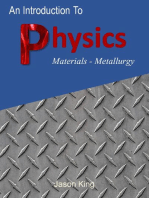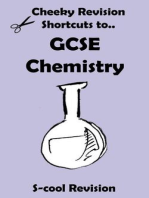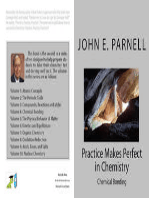12th Chemistry Unit 2 Study Material em
12th Chemistry Unit 2 Study Material em
Uploaded by
api-619694557Copyright:
Available Formats
12th Chemistry Unit 2 Study Material em
12th Chemistry Unit 2 Study Material em
Uploaded by
api-619694557Original Title
Copyright
Available Formats
Share this document
Did you find this document useful?
Is this content inappropriate?
Copyright:
Available Formats
12th Chemistry Unit 2 Study Material em
12th Chemistry Unit 2 Study Material em
Uploaded by
api-619694557Copyright:
Available Formats
Namma Kalvi
CLASS: XII www.nammakalvi.org SUBJECT: CHEMISTRY
2. p-BLOCK ELEMENTS-I
Dr.D.EZHILARASAN, PGT IN CHEMISTRY, NATIONAL HR.SEC. SCHOOL, TINDIVANAM
www.nammakalvi.org
Answer the following questions:
1. Write a short note on anomalous properties of the first element of p-block.
Small size of the first member
High ionisation enthalpy and high electronegativity
Absence of d- orbitals in their valance shell
Example:
In group 14, the first element carbon is strictly a non-metal while other elements are metalloids (silicon &
germanium) or metals (tin & lead). The first element always differs from other elements of the same group is called
anomalous behavior.
2. Describe briefly allotropism in p- block elements with specific reference to carbon.
Carbon exists in many allotropic forms. Graphite and diamond are the most common allotropes.
Other important allotropes are graphene, fullerenes and carbon nanotubes.
Graphite Diamond Fullerenes
Most stable allotropic form of carbon These allotropes are discrete
at normal temperature and pressure. molecules such as C32, C50, C60, C70,
It is soft and conducts electricity. Diamond is very hard. There is no C76 etc.
free electrons for conductivity. They have cage like structures.
Flat two dimensional sheets of carbon Carbon atom is sp2 hybridised
atoms is a hexagonal net of The tetrahedral arrangement
sp2 hybridised carbon atoms with a around each carbon atom in The C60 molecules have a soccer ball
C-C bond length of 1.41Å. diamond are sp3 hybridised. like structure and is called
C-C bond length of 1.54Å. buckminster fullerene or
buckyballs.
The successive carbon sheets are held It has a fused ring structure consists
together by weak van der Waals of 20 six membered rings and 12 five
forces. membered rings.
Carbon nanotubes, another recently discovered allotropes, have graphite like tubes with fullerene
ends.
Along the axis, these nanotubes are stronger than steel and conduct electricity.
Another allotrophic form of carbon is graphene. It has a single planar sheet of sp2 hybridised carbon
atoms that are densely packed in a honeycomb crystal lattice.
Dr.D.EZHILARASAN, PGT IN CHEMISTRY, NATIONAL HR.SEC. SCHOOL, TINDIVANAM
3. Boron does not react directly with hydrogen. Suggest one method to prepare diborane from BF3.
Boron does not react directly with hydrogen. However, it forms a variety of hydrides called boranes. The simplest
borane is diborane - B2H6. Other larger boranes can be prepared from diborane. Treatment of gaseous boron trifluoride
with sodium hydride around 450 K gives diborane. To prevent subsequent pyrolysis, the product diborane is trapped
immediately.
4. Give the uses of Borax.
Borax is used for the identification of coloured metal ions
In the manufacture optical and borosilicate glass, enamels and glazes for pottery
It is also used as a flux in metallurgy and also acts as a good preservative
5. What is catenation? Describe briefly the catenation property of carbon.
Catenation (self-bonding)
Catenation is an ability of an element to form chain of atoms.
Conditions for catenation:
The valency of the element is ≥ 2
The element should have an ability to bond with itself
The self-bond must be as strong as its bond with other elements
Kinetic inertness of catenated compound towards other molecules.
6. Write a note on Fisher tropsch synthesis.
The reaction of carbon monoxide with hydrogen at a pressure of less than 50 atm using metal catalysts at 500 -
700 K yields saturated and unsaturated hydrocarbons.
7. Give the structure of CO and CO2.
Structure of CO Structure of CO2
1 It has a linear structure. Carbon dioxide has a liner structure with equal bond distance
for the both C-O bonds.
2 Three electron pairs are shared between There is one C-O sigma bond. In addition there is 3c-4e bond
carbon and oxygen. covering all the three atoms.
3 The bonding can be explained using The bonding cannot be explained using molecular orbital
molecular orbital theory theory
4 Resonance hybrid or canonical forms Resonance hybrid or canonical forms
8. Give the uses of silicones.
Silicones are used for high temperature oil baths.
They are used for making water proofing clothes.
They are used as insulting material in electrical motor and other electrical appliances.
They are mixed with paints and enamels to make them resistant towards high temperature, sunlight, dampness
and chemicals.
Dr.D.EZHILARASAN, PGT IN CHEMISTRY, NATIONAL HR.SEC. SCHOOL, TINDIVANAM
www.nammakalvi.org
9. AlCl3 behaves like a Lewis acid. Substantiate this statement.
AlCl3 being electron deficient due to incomplete octet of central metal atom behave as Lewis acids.
In AlCl3 it forms three bonds and hence outer shell has 6 electrons.
Now Al needs two more electrons to complete its octet. So, it needs electron from outside and it exist in
dimer form and form bond with Cl atom and complete its octet.
Furthermore, Al must access both its 2s and its three 2p orbitals to bond, so it uses sp3 hybridization
(one 2s and three 2p orbitals), giving it four bonding orbitals (one of which is empty as AlCl3). This
allows it to form a fourth bond and acquire a tetrahedral structure as AlCl−4.
With one empty orbital and three electron-withdrawing Cl atoms attached, the compound is thus
an electron-acceptor at the Al center.
By definition those which accepts electrons are called Lewis acids. So AlCl3 is a Lewis acid.
Example: Friedel-Crafts Acylation reaction shows the Lewis Acid behaviour of Al in AlCl3
10. Describe the structure of diborane.
In diborane two BH2 units are linked by two bridged hydrogens. Therefore, it has eight B-H bonds. However,
diborane has only 12 valance electrons and are not sufficient to form normal covalent bonds. The four terminal B-H
bonds are normal covalent bonds (2c-2e bond). The remaining four electrons have to be used for the bridged bonds.
Hence, these bonds are 3c-2e bonds. The bridging hydrogen atoms are in a plane.
In diborane, the boron is sp3 hybridised. Three of the four sp3 hybridised orbitals contains single electron and
the fourth orbital is empty. Two of the half-filled hybridised orbitals of each boron overlap with the two hydrogens to
form four terminal 2c-2e bonds, leaving one empty and one half filled hybridised orbitals on each boron.
The (3c- 2e bonds), B-H-B bond formation involves overlapping the half-filled hybridised orbital of one boron,
the empty hybridised orbital of the other boron and the half-filled 1s orbital of hydrogen.
Dr.D.EZHILARASAN, PGT IN CHEMISTRY, NATIONAL HR.SEC. SCHOOL, TINDIVANAM
11. Write a short note on hydroboration.
Diborane adds on to alkenes and alkynes in ether solvent at room temperature. This reaction is called
hydroboration and is highly used in synthetic organic chemistry, especially for anti Markovnikov addition.
12. Give one example for each of the following
(i) icosogens - Boron & Aluminium
(ii) tetragen – Carbon & Silicon
(iii) pnictogen – Nitrogen & Phosphorous
(iv) chalcogen – Oxygen & Sulphur
13. Write a note on metallic nature of p-block elements.
Metallic nature:
The tendency of an element to form a cation by losing electrons is known as electropositive or metallic character.
This character depends on the ionisation energy. Generally on descending a group the ionisation energy
decreases and hence the metallic character increases.
In p-block, the elements present in lower left part are metals while the elements in the upper right part are
non-metals.
Elements of group 13 have metallic character except the first element boron which is a metalloid, having
properties intermediate between the metal and nonmetals.
The atomic radius of boron is very small and it has relatively high nuclear charge.
Complete the following reactions
Dr.D.EZHILARASAN, PGT IN CHEMISTRY, NATIONAL HR.SEC. SCHOOL, TINDIVANAM
www.nammakalvi.org
15. How will you identify borate radical?
When boric acid is heated with ethyl alcohol in presence of conc. H2SO4, an ester, trialkyl borate is formed.
The vapour of this ester burns with a green edged flame and this reaction is used to identify the presence of borate.
16. Write a note on zeolites.
Zeolites are three-dimensional crystalline solids containing aluminium, silicon, and oxygen in their regular
three dimensional framework.
They are hydrated sodium alumino silicates with general formula NaO.(Al2O3).x(SiO2).yH2O
(x=2 to 10; y=2 to 6).
Zeolites have porous structure in which the monovalent sodium ions and water molecules are loosely held.
The Si and Al atoms are tetrahedrally coordinated with each other through shared oxygen atoms.
Zeolites are similar to clay minerals but they differ in their crystalline structure.
Zeolites have a 3D crystalline structure looks like a honeycomb consisting of a network of interconnected
tunnels and cages. Water molecules moves freely in and out of these pores but the zeolite framework remains
rigid. Another special aspect of this structure is that the pore/channel sizes are nearly uniform, allowing the
crystal to act as a molecular sieve. We know that the removal of permanent hardness of water using zeolites.
17. How will you convert boric acid to boron nitride?
Fusion of urea with B(OH)3, in an atmosphere of ammonia at 800 - 1200 K gives boron nitride.
Dr.D.EZHILARASAN, PGT IN CHEMISTRY, NATIONAL HR.SEC. SCHOOL, TINDIVANAM
18. A hydride of 2nd period alkali metal (A) on reaction with compound of Boron (B) to give a reducing agent (C).
Identify A, B and C.
Compound A Compound B Compound C
Lithium (Li) Diborane (B2H6) Lithium aluminium hydride (LiAlH4)
19. A double salt which contains fourth period alkali metal (A) on heating at 500K gives (B). Aqueous solution of
(B) gives white precipitate with BaCl2 and gives a red colour compound with alizarin. Identify A and B.
(A) (B)
20. CO is a reducing agent. Justify with an example.
Carbon monoxide acts as a strong reducing agent.
Carbon monoxide thus has a relatively high tendency to be oxidised to form carbon dioxide. ... Its
reducing ability is utilised for example
Example: In the extraction of iron ore, haematite Fe2O3
www.nammakalvi.org
Dr.D.EZHILARASAN, PGT IN CHEMISTRY, NATIONAL HR.SEC. SCHOOL, TINDIVANAM
You might also like
- Practice On Sinusoidal and Inverse FunctionsDocument3 pagesPractice On Sinusoidal and Inverse FunctionsKinjal Koli0% (1)
- Electrical Specifications PDFDocument134 pagesElectrical Specifications PDFscoodivNo ratings yet
- P BlockDocument4 pagesP BlockAmithrajith P ANo ratings yet
- 12th Chemistry Lesson 2 Study Material English Medium PDF DownloadDocument4 pages12th Chemistry Lesson 2 Study Material English Medium PDF DownloadeswarnathjNo ratings yet
- The P Block ElementsDocument4 pagesThe P Block ElementsAthulRKrishnanNo ratings yet
- Metallic bondingDocument10 pagesMetallic bondingdivyeshrawat55No ratings yet
- Carbon and Its CompoundsDocument53 pagesCarbon and Its CompoundsSaadxOPNo ratings yet
- SS3 Emmanuel's Term Chemistry E-NoteDocument88 pagesSS3 Emmanuel's Term Chemistry E-Notefc412739No ratings yet
- Allotropy and Intermolecular ForcesDocument8 pagesAllotropy and Intermolecular ForcesD SNo ratings yet
- Cl10 Chem Notes Carbon and Its CompoundsDocument18 pagesCl10 Chem Notes Carbon and Its CompoundsMaryamNo ratings yet
- Carbon FamilyDocument33 pagesCarbon Familyk narayanaraoNo ratings yet
- Carbon and Its Compounds: Why Carbon Forms Covalent BondsDocument36 pagesCarbon and Its Compounds: Why Carbon Forms Covalent BondsVenu GopalNo ratings yet
- Introduction To BiochemistryDocument7 pagesIntroduction To Biochemistryjuniorsalim126No ratings yet
- Solution - Assignment P BLOCK ELEMENTSDocument4 pagesSolution - Assignment P BLOCK ELEMENTSYash KumarNo ratings yet
- Lecture 4-5-6Document11 pagesLecture 4-5-6kamahasanov01No ratings yet
- 2.1 The P-BlockDocument10 pages2.1 The P-BlockNonuNo ratings yet
- Lecture 11-Gr 14Document19 pagesLecture 11-Gr 14averagestudent838No ratings yet
- Chemical Bonding & Shapes of MoleculesDocument9 pagesChemical Bonding & Shapes of MoleculesEzuma LeonNo ratings yet
- Shapes of Molecules and Ions: Electron Pairs Shape Example Bond Angles and 3D ShapeDocument26 pagesShapes of Molecules and Ions: Electron Pairs Shape Example Bond Angles and 3D ShapeTripleFireWingsNo ratings yet
- 11 Chemistry Notes ch11 The P Block Element PDFDocument4 pages11 Chemistry Notes ch11 The P Block Element PDFRangbaaz DA FIRENZENo ratings yet
- 11 Chemistry Notes ch11 The P Block Element PDFDocument4 pages11 Chemistry Notes ch11 The P Block Element PDFRangbaaz DA FIRENZENo ratings yet
- Sem 1 Chapter 3 Covalent Bond Pt2Document9 pagesSem 1 Chapter 3 Covalent Bond Pt2Kishaar BaluNo ratings yet
- Carbon and Its CompoundsDocument17 pagesCarbon and Its CompoundsJoya BhatiagharuNo ratings yet
- Carbon and Its CompoundsDocument10 pagesCarbon and Its CompoundsPapia Chakraborti KumarNo ratings yet
- CARBON AND COMPOUNDS-1Document10 pagesCARBON AND COMPOUNDS-1Irene AbhilashNo ratings yet
- Dr. Anita S. Ethiraj Associate ProfessorDocument12 pagesDr. Anita S. Ethiraj Associate ProfessorGovarthananNo ratings yet
- CarbonylDocument37 pagesCarbonylmariamtariq659No ratings yet
- Carbonyles 1Document38 pagesCarbonyles 1mariamtariq659No ratings yet
- As Chemistry Unit 2 NotesDocument21 pagesAs Chemistry Unit 2 NotescluendoNo ratings yet
- Unit 2 NotesDocument26 pagesUnit 2 NotesRameez Mazhar Siddiqi100% (1)
- Carbon and Its Compounds - Short Notes (Prashant Kirad)Document16 pagesCarbon and Its Compounds - Short Notes (Prashant Kirad)dashsaiamrut001No ratings yet
- Chapter 4Document29 pagesChapter 4Mohsin ahmedNo ratings yet
- Carbon and Its CompoundDocument8 pagesCarbon and Its CompoundAprameya VasistaNo ratings yet
- POC I HybridizationDocument11 pagesPOC I Hybridizationg.alkash0375No ratings yet
- Complete Unit 2 Notes PDFDocument77 pagesComplete Unit 2 Notes PDFSan Siddz100% (1)
- I PUC Model QP AnswerDocument8 pagesI PUC Model QP AnswerSamanth PattarNo ratings yet
- P Block 11Document11 pagesP Block 11Simranpreet Singh KhalsaNo ratings yet
- Depth StudyDocument3 pagesDepth StudyPhuong TranNo ratings yet
- P - Block ElementsDocument56 pagesP - Block Elementsmusaratqamark2No ratings yet
- Revision Notes Class 11 Chemistry Chapter 11 - The P-Block ElementsDocument44 pagesRevision Notes Class 11 Chemistry Chapter 11 - The P-Block ElementsDevashree NaikNo ratings yet
- Lecture 28 PDFDocument10 pagesLecture 28 PDFS K MishraNo ratings yet
- P Block ElementsDocument12 pagesP Block ElementsHamsa SKNo ratings yet
- Classification of Organometallic CompoundsDocument28 pagesClassification of Organometallic CompoundsDingetegna GodanaNo ratings yet
- 12th Chemistry Unit 2 Study Material English Medium PDF DownloadDocument8 pages12th Chemistry Unit 2 Study Material English Medium PDF DownloadeswarnathjNo ratings yet
- CHM 113Document17 pagesCHM 113danielexoskelentonNo ratings yet
- © Ncert Not To Be Republished: Carbon and Its CompoundsDocument21 pages© Ncert Not To Be Republished: Carbon and Its CompoundsrajuramblrNo ratings yet
- Lecture 3 - Material PropertiesDocument25 pagesLecture 3 - Material PropertiesPauloConstantinoNo ratings yet
- 2.4 Introduction To Organic ChemistryDocument25 pages2.4 Introduction To Organic ChemistryMin YoonjiNo ratings yet
- Module 1 Review AnswersDocument5 pagesModule 1 Review Answerschloe.paleoNo ratings yet
- UGSemsterSyllabus Chemistry 6Sem614Chemistry English InorganicOrganicPhysicalChemistryDocument168 pagesUGSemsterSyllabus Chemistry 6Sem614Chemistry English InorganicOrganicPhysicalChemistryAnil GugulothNo ratings yet
- Carbon and Its CompoundsDocument7 pagesCarbon and Its CompoundsrishikeshsunbeamianNo ratings yet
- Inorganic Chemistry Lesson 10 CHEMICAL BONDING PDFDocument41 pagesInorganic Chemistry Lesson 10 CHEMICAL BONDING PDFKayra Myke VelascoNo ratings yet
- Inorganic ChemistryDocument22 pagesInorganic ChemistryuniquestarNo ratings yet
- F BlockDocument25 pagesF Blockshurshtikarande18No ratings yet
- Carbon and Its CompoundsDocument7 pagesCarbon and Its CompoundsnoNo ratings yet
- Class 11 Chemistry Chapter 3 Classification of Elements and Periodicity in Properties Important Questions With AnswersDocument16 pagesClass 11 Chemistry Chapter 3 Classification of Elements and Periodicity in Properties Important Questions With Answers9080213121sNo ratings yet
- Analytical Chemistry Lec1Document21 pagesAnalytical Chemistry Lec1احمد الطائيNo ratings yet
- GCSE Chemistry Revision: Cheeky Revision ShortcutsFrom EverandGCSE Chemistry Revision: Cheeky Revision ShortcutsRating: 4.5 out of 5 stars4.5/5 (3)
- Practice Makes Perfect in Chemistry: Chemical BondingFrom EverandPractice Makes Perfect in Chemistry: Chemical BondingRating: 5 out of 5 stars5/5 (3)
- Organic Reaction Mechanisms 1982: An annual survey covering the literature dated December 1981 through November 1982From EverandOrganic Reaction Mechanisms 1982: An annual survey covering the literature dated December 1981 through November 1982A. C. KnipeNo ratings yet
- 3500/72M Recip Rod Position Monitor: Operation and Maintenance ManualDocument158 pages3500/72M Recip Rod Position Monitor: Operation and Maintenance ManualNOEMINo ratings yet
- JINKO - Manual IEC2016-2022.06.23 - (EN-4+6)Document70 pagesJINKO - Manual IEC2016-2022.06.23 - (EN-4+6)David LeeNo ratings yet
- 658 1405 1 SMDocument16 pages658 1405 1 SMIdrissa BaNo ratings yet
- Aug15 815 GomesDocument128 pagesAug15 815 GomesPedro BragatoNo ratings yet
- Weakly Differentiable Functions Volume 120 - Pointwise Behavior of Sobolev FunctionsDocument65 pagesWeakly Differentiable Functions Volume 120 - Pointwise Behavior of Sobolev FunctionsHam Karim RUPPNo ratings yet
- Turbo Docs P-01739 - PLN WKSKT - Serious Inspection STG PLTU Asam Asam Unit #1 - Rev-0 (1-Turbine)Document112 pagesTurbo Docs P-01739 - PLN WKSKT - Serious Inspection STG PLTU Asam Asam Unit #1 - Rev-0 (1-Turbine)Novi GaluhNo ratings yet
- Hammer Drillbit 01Document3 pagesHammer Drillbit 01Ruben PradaNo ratings yet
- Interplanetary Magnetic FieldDocument7 pagesInterplanetary Magnetic FieldYohanan Bolishetti (OMP)No ratings yet
- 65-4-3 MathematicsDocument23 pages65-4-3 Mathematics18-Mir Rayhan AlliNo ratings yet
- 2019 Prelim Topic - Complex Numbers - Solutions PDFDocument44 pages2019 Prelim Topic - Complex Numbers - Solutions PDFLeng RyanNo ratings yet
- Sow S2 PhysicsDocument33 pagesSow S2 Physicskawumaronald068No ratings yet
- Calpeda Pump DatasheetDocument16 pagesCalpeda Pump DatasheetAhamed HussanNo ratings yet
- Astm E155Document4 pagesAstm E155王玮No ratings yet
- Sample Final OutputDocument3 pagesSample Final OutputRey Dominique VillarNo ratings yet
- Lecture 8: Voltage Regulation: ECE 5984: Power Distribution System AnalysisDocument34 pagesLecture 8: Voltage Regulation: ECE 5984: Power Distribution System Analysisante mitarNo ratings yet
- Navigation GeneralDocument39 pagesNavigation GeneralReeshi RajNo ratings yet
- Introduction To Three Dimensional Geometry: General Key ConceptsDocument5 pagesIntroduction To Three Dimensional Geometry: General Key ConceptsGurpreet SinghNo ratings yet
- MYP 4 Worksheet 1Document3 pagesMYP 4 Worksheet 1ayaansrivastava09No ratings yet
- CGL20T1 13 Aug 3PM EN (WWW - Qmaths.in)Document30 pagesCGL20T1 13 Aug 3PM EN (WWW - Qmaths.in)HrithvikWaitforitBhardwajNo ratings yet
- Chapter 3 PumpDocument12 pagesChapter 3 PumpChun ChinNo ratings yet
- Design and Analysis of A New GaN-based AC DC Topology For Battery Charging ApplicationDocument6 pagesDesign and Analysis of A New GaN-based AC DC Topology For Battery Charging Applicationshibijith.m24No ratings yet
- Section A //X Write The Answer of The Following Questions. (Each Carries 2 Marks)Document10 pagesSection A //X Write The Answer of The Following Questions. (Each Carries 2 Marks)Dhruv ParmarNo ratings yet
- Astm C1619 11Document3 pagesAstm C1619 11Sandeep gotraNo ratings yet
- Fault Zone Analysis "ROTOR"Document8 pagesFault Zone Analysis "ROTOR"abhe prasetyaNo ratings yet
- Artigo 2015 OSBDocument12 pagesArtigo 2015 OSBVania SaNo ratings yet
- Aerodynamics Principles For PilotsDocument437 pagesAerodynamics Principles For PilotsErick Valadares OliveiraNo ratings yet
- Geometrical OpticsDocument19 pagesGeometrical OpticsRaju Singh100% (1)
- VPTF3-28 Series: High Reliability Cots Emi FiltersDocument7 pagesVPTF3-28 Series: High Reliability Cots Emi Filtersdnn38hdNo ratings yet

























































































